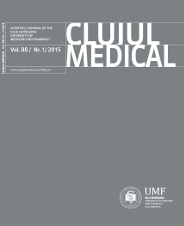The added value of color parameters in analyzing elastographic images of ultrasound detected breast focal lesions
DOI:
https://doi.org/10.15386/cjmed-363Keywords:
breast, ultrasound, elastography, color analysisAbstract
Aims. The purpose of the study was to determine if the color quantitative analysis obtained on elastographic images of breast lesions could improve the benign-malignant differentiation, and also to identify some of the circumstances which would benefit most from such an analysis.
Patients and methods. The study design was a longitudinal prospective one, all data being acquired between May 2007 and September 2008. The US device used: Hitachi 8500 EUB machine with elastography option. For suspicious breast lesions histopathology was obtained by means of percutaneous biopsy or post-surgery. Studied color parameters (numeric values): average color (red, green, blue), color dispersion, average intensity, average hue, hue dispersion. Calculus modality: Image Processing Version 1.3, a program developed in collaboration with the Technical University of Cluj Napoca.
Results. Seventy-one (71) women were selected for the study. A hundred and six circumscribed breast lesions were detected by means of ultrasound in the studied group. Five color parameters were independently associated with the histological diagnosis (AvgBlue, AvgGreen and AvgRed; DispRed and DispIntensity) with AvgBlue parameter making the most important contribution (p<0.0001); the greater the values of AvgBlue (more than 92), the higher the chances of malignancy and the greater the values of AvgGreen (more than 88), the higher the chances for a benign lesion.
Conclusion. High numeric values for Avg Blue (more than 92) would increase the probability of malignancy and thus recommend a more aggressive diagnostic management (biopsy), while high numeric values for AvgGreen (more than 88) would reassure the examiner to proceed conservatively with short interval or routine follow-ups.
Downloads
Additional Files
Published
How to Cite
Issue
Section
License
The authors are required to transfer the copyright of the published paper to the journal. This is done by agreeing to sign the Copyright Assignment Form. Whenever the case, authors are also required to send permissions to reproduce material (such as illustrations) from the copyright holder.

The papers published in the journal are licensed under a Creative Commons Attribution-NonCommercial-NoDerivatives 4.0 International License.

